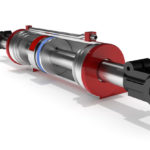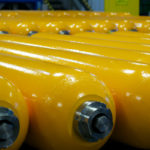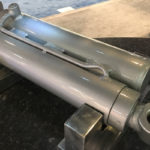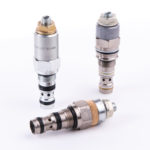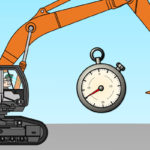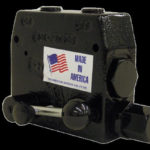Several technologies exist to provide position feedback or data of a cylinder’s position. Linear position sensors convert the position into a proportional analog or digital signal. LVITs—Linear Variable Inductive Transducers—are contactless position sensing devices, with sensing ranges up to 30 inches or more. Most designs feature an inductive probe surrounded by a conductive tube. This is […]
Engineering Basics
How does a hydraulic accumulator work?
Hydraulic accumulators are energy storage devices. Analogous to rechargeable batteries in electrical systems, they store and discharge energy in the form of pressurized fluid and are often used to improve hydraulic-system efficiency. An accumulator itself is a pressure vessel that holds hydraulic fluid and a compressible gas, typically nitrogen. The housing or shell is made […]
The ins and outs of piggy-back hydraulic cylinders
Piggy-back cylinders, as the name implies, are two opposing hydraulic cylinders mounted with the bodies on top of each other. Taking advantage of this configuration enables a longer stroke from a relatively short overall length. They’re somewhat similar to familiar telescoping cylinders, where several cylinder stages are built inside of one another, and the unit […]
Load-holding valves made simple
Load-holding valves, or counterbalance valves, are simple devices but critical to mobile machine stability and cost. Contributed by Todd McIntryre, Global Planning and Strategy Manager, SiCV, Eaton Load-holding valves, which are also known as counterbalance valves, are a small but important part of any mobile machine. Though they are simple in design, their application can often […]
How much hydraulic safety awareness do you have?
Hydraulic safety knowledge and respect for the hazards of hydraulics is gained through training and mentoring; however, the practice of learn as you go is an unacceptable way to gain safety knowledge. Even though electrical components meet standards, when they are assembled into a circuit, the circuit must be inspected to meet codes of the […]
How can you keep your mobile machine running efficiently? Part 2
Using a scientific approach to mobile machine maintenance helps technicians have a better handle on the fundamentals of hydraulic components. By Carl Dyke, CD Industrial Group Inc. Last November, we delved into system-specific maintenance tips to ensure the hydraulics on your mobile machine runs at its highest performing levels. We continue this discussion with a look at more […]
What is flow sharing?
By Josh Cosford, Contributing Editor Flow sharing is a method of pressure compensation allowing all channels of metered fluid to take proportional allocation of flow regardless of total pump output. Flow sharing prevents fluid from taking the path of least resistance. To explain, first consider that you have two directional valves with flow controls plumbed […]
What is pressure compensation?
You’ve been around hydraulics a while, haven’t you? With that in mind, you probably take some things for granted. There is plenty of jargon in our industry, and it isn’t learned overnight. However, if you were like me, the term pressure compensation was difficult to grasp early in your hydraulic career. If you still don’t […]
How can you keep your mobile machine running efficiently? Part 1
Learning how to properly maintain your hydraulic system with precision will help support a high-performance, well-functioning machine. By Carl Dyke, Contributing Editor Half of the battle in hydraulic system troubleshooting is knowing exactly what ‘normal’ is. It’s hard to diagnose a component or a section of a system without knowing normal parameters, such as: Speeds Pressure Valve […]
When should you use high-pressure motors?
High-pressure motors are able to accomplish more in a smaller package compared to medium-pressure technology. When it comes to enhancing performance of both mobile and stationary hydraulic systems, high-pressure technology can be used to reduce package size, improve starting torque, and reduce system costs. At the end of the day, this means that skid steer […]

